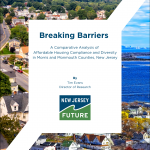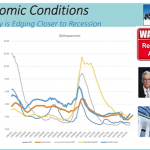New Jersey Future Blog
Non-English-Speakers More Common in NJ than Nationally
April 27th, 2010 by Tim Evans

image source: United Nations
The Census Bureau has just released new data on people age 5 and older who speak a language other than English at home. The press release mentions New Jersey twice, as being among the states with the highest percentages of speakers of Slavic languages and of Korean.
A quick analysis of the linked data tables reveals a few interesting facts about New Jersey’s speakers of other languages, as compared to the country as a whole:
- People in New Jersey 5 years old or older who speak a non-English language at home make up 27.6 percent of the state’s 5+ population, much higher than the national figure of 19.6 percent. Not speaking English at home is nearly 50 percent more common in NJ than in the US overall.
- Of those not speaking English at home in New Jersey, 50 percent speak Spanish, compared to 62 percent nationally. In New Jersey, non-English-speakers are more likely to be speaking something other than Spanish than is true nationwide.
- 4.0 percent of those not speaking English at home in New Jersey are speaking Italian, as compared to only 1.5 percent nationally.
- 3.7 percent speak Portuguese, vs. 1.2 percent nationally
- 3.5 percent speak Tagalog [the native language of the Philippines], vs. 2.6 percent nationally
- 3.3 percent speak Mandarin Chinese, vs. 2.8 percent nationally
- 3.2 percent speak Korean, vs. 1.9 percent nationally
- 2.9 percent speak Polish, vs. 1.1 percent nationally
- 2.7 percent speak Gujarati, vs. 0.5 percent nationally
- 2.3 percent speak Hindi, vs. 1.0 percent nationally
- 2.2 percent speak Arabic, vs. 1.4 percent nationally
-
2.0 percent speak Russian, vs. 1.5 percent nationally
So New Jersey has proportionally more than 5 times as many people speaking Gujarati at home as does the US, more than 3 times as many speaking Portuguese, nearly 3 times as many speaking Italian and Polish, and more than double the percent speaking Hindi. Speakers of Tagalog, Mandarin Chinese, Korean, Arabic, and Russian are also over-represented in NJ relative to the US.
In contrast, languages spoken by at least 2 percent of all at-home non-English-speakers nationally but by less than 2 percent of those in New Jersey include French, Vietnamese, and German. So at-home speakers of these languages, in addition to Spanish, are relatively less prevalent in NJ than in the US.
Incidentally, the report found only 23 speakers of Pennsylvania Dutch in New Jersey, compared to 46,000 in Pennsylvania (and 23 K in Ohio and 18 K in Indiana). New Jerseyans will have to continue relying on their western neighbor for their scrapple, birch beer, and shoo-fly pie.
Related Posts
Tags: Demographics, Languages
















